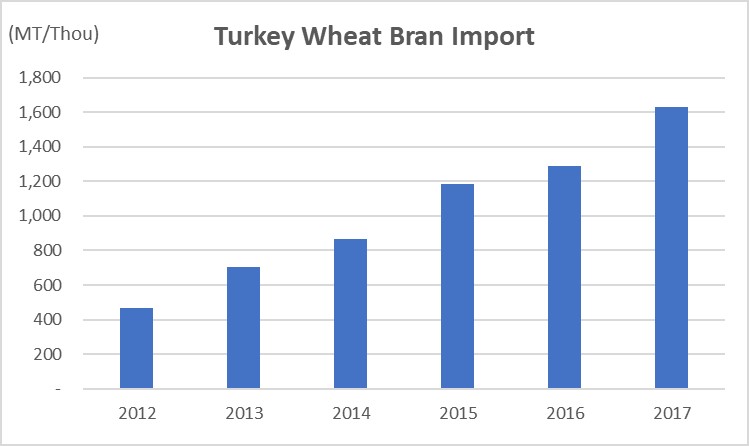Feed the Cows!
Wheat bran is the by-product of dry milling of common wheat, and its cost efficiency and rich nutritional values have allowed its versatile application in various industries. Wheat bran is most widely used in the agricultural industry for its suitability as livestock feed. Wheat bran is usually sold in pellet form or raw. It is often added to heavy feed mixtures when in need of extra dietary fiber in livestock feed. Other industries that are rising in demand for wheat bran include the culinary, the medical and the cosmetics. Although new adaptations of wheat bran are being continuously discovered, the agricultural industry will remain as the dominant market in demand of wheat bran.
Turkey stands first in the global wheat bran import market. According to Tridge, the nation occupies 20% of the whole import market, and both the quantity and value of import have increased over the past years. The quantity surged by 20% in 2017 from the previous year to mark 1.7 million metric tons. The continuous increase of wheat bran import in Turkey attributes to the feed sector, which increased 32% just over a year in 2017. Among other uses, animal feed is one of the most popular ways wheat bran is consumed. Especially in the mixed feed for cattle breeding and fattening, wheat bran shares 44% of the feed proportion. It provides high nutrition to livestock along with corn, barley, and other crops mixed in the feed.

Major importers of wheat bran (Source: Tridge)
The quantity surged by 20% in 2017 from the previous year to mark 1.7 million metric tonnes. The continuous increase of wheat bran import in Turkey attributes to the feed sector, which increased 32% just over a year in 2017. Among other uses, animal feed is one of the most popular ways wheat bran is consumed. Especially in the mixed feed for cattle breeding and fattening, wheat bran shares 44% of the feed proportion. It provides high nutrition to livestock along with corn, barley, and other crops mixed in the feed.
Deficiency in Beef Drive Demands in Turkey

Wheat bran is one of most commonly used animal feed
To understand the recent growth of the animal feed industry, the long-going controversy over the meat supply deficiency in Turkey must first be acknowledged. The Turkish government has long been attempting to tackle the short meat supply dilemma since 2010. In 2017, Ahmet Esref Fakibaba, the newly appointed minister of Ministry of Food, Agriculture, and Livestock, announced that the office will focus on resolving the high meat price problem. In 2018, Turkey is to double its amount of cattle imports following the newly announced Council of Minister's Decree.
From 2002 to 2016, the demand for animal feed quadrupled, while the domestic production of grains suitable for livestock feed increased merely by 13%. The government increased the share for livestock feed from total grain production from 2.2% to 7.3% in an attempt to resolve the shortage issue. Yet, supply had to be supplemented by an imported animal feed from overseas.

Turkey's wheat bran import has been on a constant rise (source: USDA data)
The Turkish government maintained low import tariff of 5% to vitalize import of grains used in animal feed. In November 2017, the government took a step further to completely eliminate the import tariff. The effect of the new tariff law is forecasted to increase wheat bran import even further.
The export figures of Russia and Ukraine, 1st and 3rd in wheat bran export respectively, have burgeoned from the rising wheat bran demand of Turkey. For the first half of MY 2017/18, Russia exported 462,300 tonnes, which 90% of the volume was absorbed by Turkey. Russia showed 4.4% increase in export year-to-year. Ukraine experienced a more dramatic increase of 24% over the same period, resulting in 330,200 tonnes. Of note, Ukraine had exported 568,200 tonnes, with Turkey importing 541,300 tonnes of them.
Turkey will Continue to Import
Despite the recent effort, the problem of beef deficiency is yet to be resolved. The demand for beef is mainly driven by the rapid urbanization and the rising middle-class population that consumes beef on a more daily basis. For the past decade, Turkey has been showing a steady increase in urbanization rate and population, and this trend is expected to continue.
Wheat price is the main index to consider when searching for wheat bran supplier. FAO study reveals a very strong correlation between prices of wheat and wheat bran, yielding R-value of 0.85. Though the price volatility of wheat remains fairly low at 5.78%, various market conditions may cause a regional difference in wheat price. If Turkey is to import more wheat bran, which is an easily expected trend, the nation will have to consider other supplier options as well. While its primary suppliers Russia and Ukraine are showing an increase in their wheat bran production, Turkey already shares more than 90% of their export, which limits the meaningful additional growth of the figure.
Kazhakstan, 14th in wheat bran export according to Tridge, is one of the main suppliers with low share by Turkey. Uzbekistan is the major import of Kazakhstan wheat bran, while Turkey's import share comprises only 13%. Indonesia, which comes after Russia in wheat bran export, is another viable option for wheat bran import. The price, however, tends to be relatively expensive than offers of other countries, for Indonesia does not domestically produce wheat and fully relies on import.
Contact Us:
Editor: Wonjung Yun / wonjung.yun@tridge.com
Sourcing Team Expert: Elly Lee / eunjeong.lee@tridge.com
Or request for quotation through: https://www.tridge.com/inquiry
References
3. http://www.blackseagrain.net/